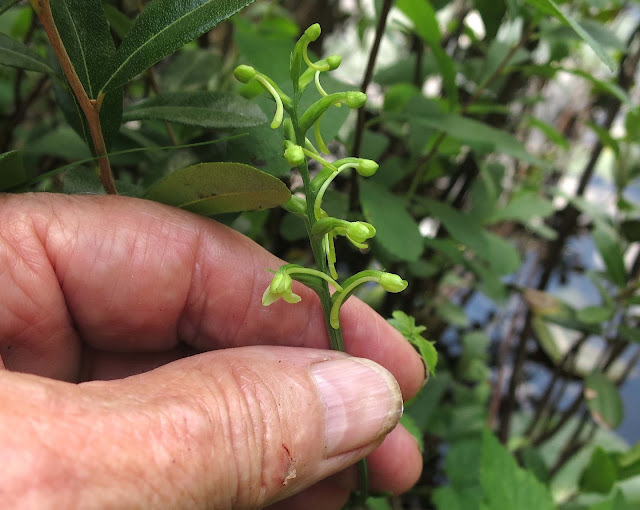I, personally, wanted to go up to Lake Desolation last week to explore a lakeside bog for some plants I was hoping to find, and I hoped my friends in the Thursday Naturalists would like to join me. Surprisingly enough (considering it's not an easy walk, even in the best of weathers), some of them did. When Thursday came, though, it was hardly the best of weathers. In fact, it was raining hard and rather chilly. But these are dedicated plant nerds (I mean that name admiringly), and so we all pushed into this rain-soaked forested wetland, excited about what we might find.
Lake Desolation lies high in the mountainous northern regions of Saratoga County, and it's a small, quiet lake surrounded by miles of state forest preserve. The wetland we wanted to explore lies on a thickly forested shore of the lake, and although this wetland does not fit the classic definition of a true bog, many of the plants that inhabit it are what typically grow in the kind of acidic peatland we often refer to as boggy. And with the rain pouring down on Thursday, we could also have referred to this wetland as soggy.
My friends Sue and Ruth and I had previewed this wetland the week before, on a warmer and sunnier day, and were able to entice our friends with reports of what we had found.
The prize plants were, of course, the two orchids we found pushing up from the damp mossy ground. Ragged Fringed Orchid (Platanthera lacera) was the first one we found, an orchid with blooms that certainly fit the descriptive terms of ragged and fringed.
The second orchid we found also lived up to its name, that of Small Green Wood Orchid (Platanthera clavellata), with flowers that are small and green and growing in the shade of the woods. Another distinctive feature of this orchid is the long, curving spur that extends from the bottom of each floret, suggesting another of its common names, the Club-spur Orchid.
Our Thursday Naturalist group rarely gets to explore this kind of wetland, since most sphagnum bogs and fens require over-water paddles to get to. But this one we could just walk into, even though we had to jump some puddles and push through thickets to find such peatland denizens as this Northern Pitcher Plant (Sarracenia purpurea) with its oddly shaped leaves and tall flower stalk sporting one big green bloom.
We also saw lots of the tiny carnivorous plant called Round-leaved Sundew (Drosera rotundifolia) spreading across the forest floor.
If there is one single plant that best symbolizes our northern peatlands, it would have to be the shrubby Labrador Tea (Rhododendron groenlandicum). Here on the shore of Lake Desolation, we found lots and lots of Labrador Tea, with its orange-flocked stems and aromatic leaves.
As the rain fell harder, soaking the shrubs we had to push through (there are no nicely groomed trails through this wooded wetland), we, too, grew soaked, with pant-legs wet to the thigh. But did I hear a single peep of complaint? Oh no, not one peep! Only shouts of surprise and joy at all the amazing plants we were finding. This is one game bunch of botanizers.
One of my favorite finds of the day was the abundant number of Mountain Holly shrubs (Ilex mucronata), each shrub thick with berries of the most beautiful super-saturated red that seemed to glow through the rain-dark gloom.
Mats of bright-green sphagnum moss lay everywhere, but this mound of pink sphagnum (Sphagnum capillifolium) came as quite a surprise.
We also saw lots and lots of mushrooms, but this large patch of intensely vivid Orange Waxcaps certainly stood out from all the rest.
The button stage of this mushroom is even more intensely colored.
There were two plants I was determined to locate, needing both to add to my collection of specimens missing from the Saratoga County plant atlas. Previous trip reports for this location indicated I might find Bog Rosemary (Andromeda polifolia) here. And so I did. I found no flowers or fruits on the few stems I did manage to locate, but there was no mistaking the blue-green color of its small lance-like, under-rolled leaves that were silvery on the back. (Ignore those brown-stemmed twigs I am also holding, which I think may have come from a Bog Laurel shrub, but I never found enough evidence -- like flower clusters -- to confirm my suspicion.)
The other plant I sought for the county atlas was the Virginia Chain Fern (Woodwardia virginica), distinguished by its habit of growing in single fronds along a ropy underground rhizome instead of in multi-frond clumps. These ferns with their dark stalks and widely spaced pinnulae appeared to fit the description.
The clincher assuring me that this really was the Virginia Chain Fern appeared when I looked on the back of the fronds. There I found the signature worm-shaped spore cases (sori), as well as the distinctive "chain-link" veining of the pinnae, both of which are definitive for this species of fern.
Those two finds alone were, for me, well worth the discomforts of slogging through mud, soaked to the skin and scratched by the Black Spruce branches I had to push through to find them. And I'm happy to report that my other companions also had a good time, judging from their smiles and their cheerful chatter about all our remarkable finds.
















2 comments:
Fascinating place and great finds, but then wetlands are usually interesting.
Wonderful bog I have paddled to. It seems though it is actually on private land so walking from the road is not possiblle unless not posted?
Post a Comment